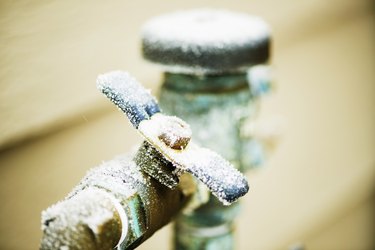Preventing Pipes from Cold Weather: Effective Strategies
Preventing Pipes from Cold Weather: Effective Strategies
Blog Article
They are making a few great pointers regarding How To Avoid Freezing Pipes as a whole in this article following next.

Winter can damage your plumbing, particularly by freezing pipes. Here's how to avoid it from happening and what to do if it does.
Introduction
As temperatures decline, the danger of frozen pipes rises, possibly bring about expensive fixings and water damages. Recognizing exactly how to avoid icy pipes is vital for property owners in cold environments.
Comprehending Frozen Pipelines
What creates pipelines to ice up?
Pipes ice up when revealed to temperatures below 32 ° F (0 ° C) for expanded periods. As water inside the pipelines ices up, it expands, taxing the pipeline walls and potentially triggering them to burst.
Dangers and problems
Frozen pipelines can cause water supply disturbances, building damage, and costly repair work. Ruptured pipes can flood homes and trigger extensive structural damage.
Indicators of Frozen Pipes
Identifying frozen pipelines early can prevent them from bursting.
Exactly how to recognize icy pipelines
Seek lowered water circulation from faucets, unusual smells or noises from pipelines, and visible frost on revealed pipes.
Avoidance Tips
Insulating vulnerable pipelines
Wrap pipes in insulation sleeves or make use of heat tape to secure them from freezing temperature levels. Concentrate on pipes in unheated or external areas of the home.
Home heating techniques
Keep interior rooms adequately heated up, especially locations with pipes. Open cupboard doors to permit warm air to distribute around pipes under sinks.
Securing Exterior Plumbing
Yard pipes and outside faucets
Separate and drain pipes garden hoses prior to wintertime. Mount frost-proof spigots or cover outside taps with insulated caps.
What to Do If Your Pipes Freeze
Immediate activities to take
If you suspect icy pipelines, maintain taps open up to ease pressure as the ice thaws. Use a hairdryer or towels soaked in hot water to thaw pipes slowly.
Long-Term Solutions
Structural modifications
Take into consideration rerouting pipelines far from outside wall surfaces or unheated locations. Add extra insulation to attic rooms, cellars, and crawl spaces.
Upgrading insulation
Purchase top quality insulation for pipelines, attic rooms, and walls. Correct insulation aids maintain regular temperature levels and minimizes the risk of icy pipes.
Verdict
Preventing frozen pipes needs proactive procedures and quick actions. By comprehending the causes, signs, and safety nets, home owners can secure their plumbing during cold weather.
5 Ways to Prevent Frozen Pipes
Drain Outdoor Faucets and Disconnect Hoses
First, close the shut-off valve that controls the flow of water in the pipe to your outdoor faucet. Then, head outside to disconnect and drain your hose and open the outdoor faucet to allow the water to completely drain out of the line. Turn off the faucet when done. Finally, head back to the shut-off valve and drain the remaining water inside the pipe into a bucket or container. Additionally, if you have a home irrigation system, you should consider hiring an expert to clear the system of water each year.
Insulate Pipes
One of the best and most cost-effective methods for preventing frozen water pipes is to wrap your pipes with insulation. This is especially important for areas in your home that aren’t exposed to heat, such as an attic. We suggest using foam sleeves, which can typically be found at your local hardware store.
Keep Heat Running at 65
Your pipes are located inside your walls, and the temperature there is much colder than the rest of the house. To prevent your pipes from freezing, The Insurance Information Institute suggests that you keep your home heated to at least 65 degrees, even when traveling. You may want to invest in smart devices that can keep an eye on the temperature in your home while you’re away.
Leave Water Dripping
Moving water — even a small trickle — can prevent ice from forming inside your pipes. When freezing temps are imminent, start a drip of water from all faucets that serve exposed pipes. Leaving a few faucets running will also help relieve pressure inside the pipes and help prevent a rupture if the water inside freezes.
Open Cupboard Doors
Warm your kitchen and bathroom pipes by opening cupboards and vanities. You should also leave your interior doors ajar to help warm air circulate evenly throughout your home.

Hopefully you enjoyed reading our piece about How to Prevent Your Pipes From Freezing. Thank you so much for taking time to read through our blog. I beg you take the opportunity to distribute this blog if you enjoyed reading it. Thank you for your time. Please come by our blog back soon.
Request An Appointment Report this page